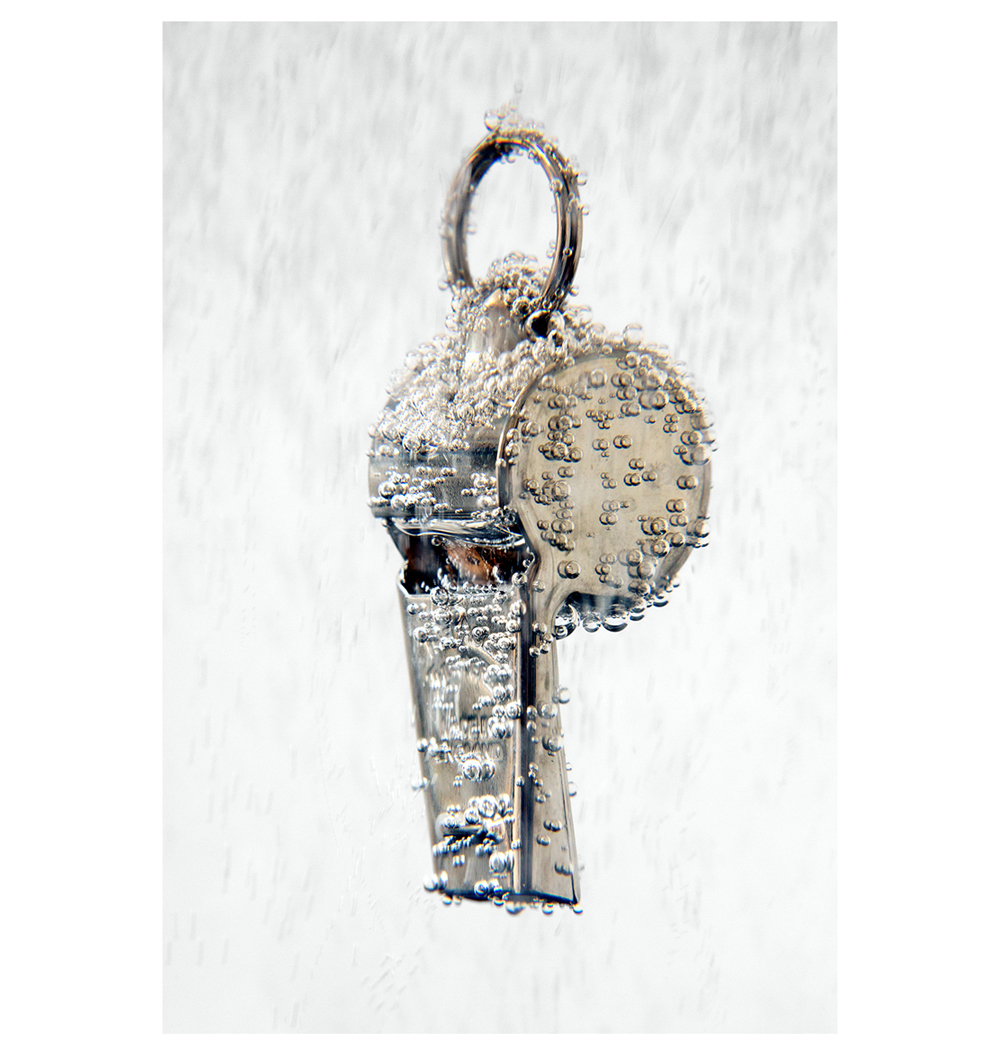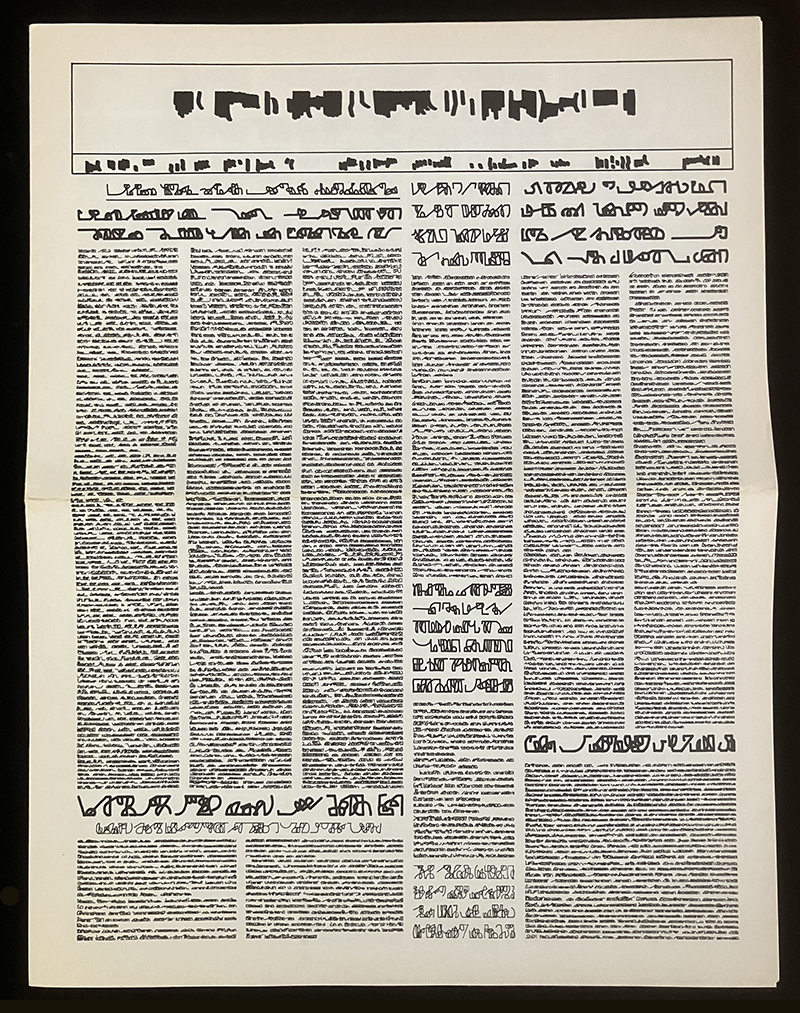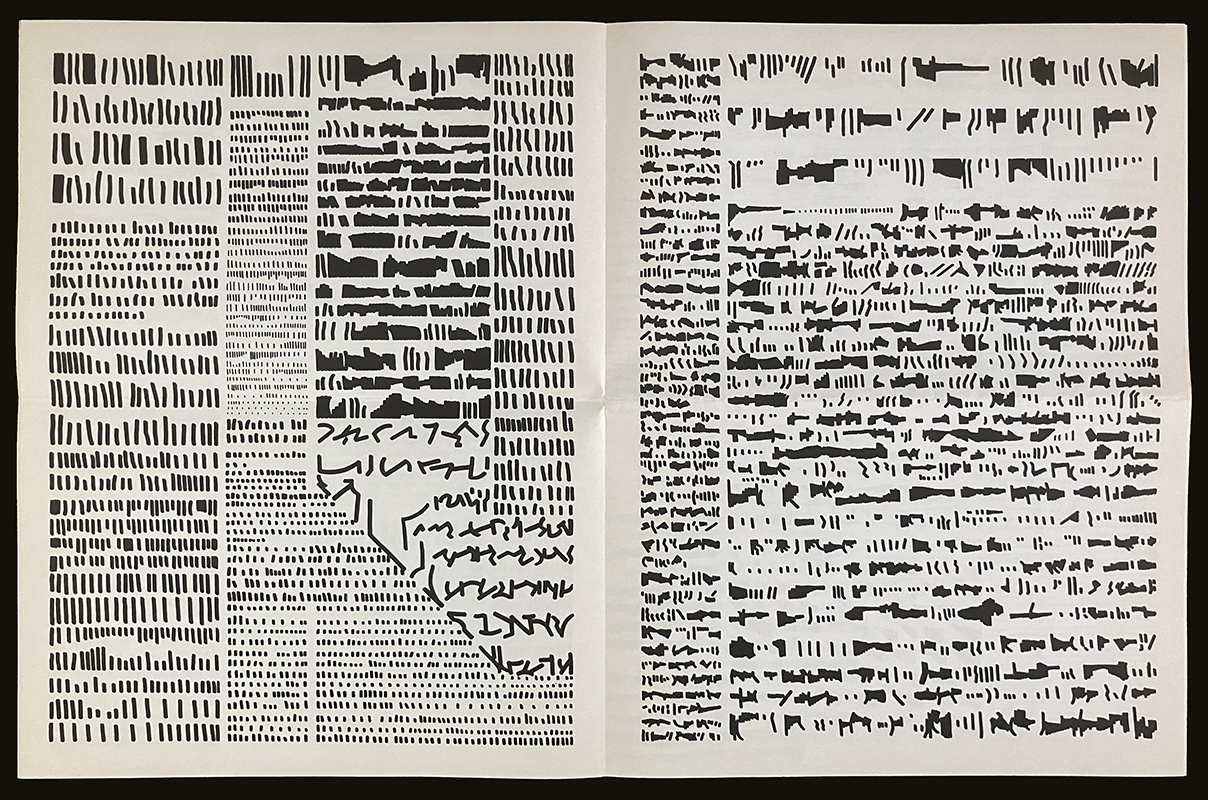
Demetrius Oliver, Breed (2023). Digital video still, 19:45 minutes

Diario no. 1, ano 1 (1975). Offset ink on broadsheet newsprint, page 1

Diario no. 1, ano 1 (1975). Offset ink on broadsheet newsprint
Demetrius Oliver and Mirtha Dermisache
September 15 - 29, 2024
Broodthaers Society of America
520 West 143rd Street
New York, NY 10031
Tuesdays, Fridays, and Sundays, noon - 6:00pm and by appointment
closed Wednesdays and Thursdays
The Broodthaers Society of America is pleased to screen Breed (2023), Demetrius Oliver's digital video that premiered in Houston last year. The video will loop continuously during regular gallery hours through Sunday, September 29. It can also be seen in its entirety by appointment.
Like all of Oliver's work, Breed presents us with an, at once, utterly familiar and utterly strange scenario: in this case a standard-issue stainless steel whistle suspended vertically in a glass of club soda. These details don't matter for long, however, as the sheer physical facts and beauty of the image obviate the questions of how, or why, we're looking at it. The bubbles, being air, race in the right direction for blowing the whistle but lack the force and volume to do so. In any case, the whistle is completely submerged and can't make a sound. Instead, the bubbles cling to the whistle until, overwhelmed by natural forces, they're whisked away one by one. Some are so small as to resist this inevitability, their surface tension outweighing gravitational force and making a lasting reflection, narcissus like, on the whistle's surface. Larger bubbles get trapped in its ledges and undercuts. So it goes for almost twenty minutes, punctuated by the periodic escape of a single, giant bubble—baa-loomp!—from the whistle's sound chamber.
Breed is paired with an extraordinary copy of Mirtha Dermisache's Diary no. 1, year 1 (1975), an offset ink-printed broadsheet that proposes a wholly different idea of what it means to read. Although Diary no. 1, year 1 may look like an elaborate form of redaction, Dermisache insisted that her work was not a negation of language, or legibility, per se. Rather, it expresses what she called "graphisms," a complex system of mark-making that had its own perceptible syntax and logic in relation to language in general and the cognitive scaffolding of printed matter in particular. In this case, being able to sit and flip through an actual copy of Diary no. 1, year 1 is an opportunity not to be missed.
Each work heightens our sense of sound and silence. Each work, in its own way, induces a synesthetic, out-of-body experience.
Demetrius Oliver (b. 1975 , Brooklyn) is an artist who revels in the paradox of making mundane things seem otherworldly. His use of such items as tea kettles, rooftop ventilators, shattered umbrellas, and coal have always lent his work a disarming, enigmatic affect. Recent exhibitions include Heliacal, a solo show at Inman Gallery, Houston, and The Dirty South: Contemporary Art, Material Culture, and the Sonic Impulse, a traveling group exhibition organized by the Virginia Museum of Fine Arts, Richmond. Oliver has also been awarded residencies at Skowhegan, Maine, the Core Program, Houston, and the Studio Museum, Harlem. He lives and works in Harlem.
Mirtha Dermisache (1940-2012, b. Buenos Aires) was an artist known for her expansive approach to writing, which she realized in the form of drawings, letters, postcards, posters, newsletters, and artist's books. Having cut her teeth on the concrete art and poetry of postwar Argentina and Brazil—as well as her home country's lethal authoritarian politics—Dermisache's work was ultimately more aligned with the theoretical distinctions of Roland Barthes' Writing Degree Zero and various European artist's book publishers (such as Guy Schraenen) and literary movements (such as Asemic writing). Her works are in the public collections of the Centre Pompidou, Paris, MACBA, Barcelona, and MoMA, New York.
Demetrius Oliver and Mirtha Dermisache is part of Amphiphrasis, a series of exhibitions about the descriptive power of art with and without the use of words. The term is inspired by Marcel Broodthaers' use of phonemic objects like mussel shells to describe, so to speak, the social conditions of his artworks.
Broodthaers Society of America
520 West 143rd Street
New York, NY 10031
Tuesdays, Fridays, and Sundays, noon - 6:00pm and by appointment
closed Wednesdays and Thursdays
The Broodthaers Society of America is pleased to screen Breed (2023), Demetrius Oliver's digital video that premiered in Houston last year. The video will loop continuously during regular gallery hours through Sunday, September 29. It can also be seen in its entirety by appointment.
Like all of Oliver's work, Breed presents us with an, at once, utterly familiar and utterly strange scenario: in this case a standard-issue stainless steel whistle suspended vertically in a glass of club soda. These details don't matter for long, however, as the sheer physical facts and beauty of the image obviate the questions of how, or why, we're looking at it. The bubbles, being air, race in the right direction for blowing the whistle but lack the force and volume to do so. In any case, the whistle is completely submerged and can't make a sound. Instead, the bubbles cling to the whistle until, overwhelmed by natural forces, they're whisked away one by one. Some are so small as to resist this inevitability, their surface tension outweighing gravitational force and making a lasting reflection, narcissus like, on the whistle's surface. Larger bubbles get trapped in its ledges and undercuts. So it goes for almost twenty minutes, punctuated by the periodic escape of a single, giant bubble—baa-loomp!—from the whistle's sound chamber.
Breed is paired with an extraordinary copy of Mirtha Dermisache's Diary no. 1, year 1 (1975), an offset ink-printed broadsheet that proposes a wholly different idea of what it means to read. Although Diary no. 1, year 1 may look like an elaborate form of redaction, Dermisache insisted that her work was not a negation of language, or legibility, per se. Rather, it expresses what she called "graphisms," a complex system of mark-making that had its own perceptible syntax and logic in relation to language in general and the cognitive scaffolding of printed matter in particular. In this case, being able to sit and flip through an actual copy of Diary no. 1, year 1 is an opportunity not to be missed.
Each work heightens our sense of sound and silence. Each work, in its own way, induces a synesthetic, out-of-body experience.
Demetrius Oliver (b. 1975 , Brooklyn) is an artist who revels in the paradox of making mundane things seem otherworldly. His use of such items as tea kettles, rooftop ventilators, shattered umbrellas, and coal have always lent his work a disarming, enigmatic affect. Recent exhibitions include Heliacal, a solo show at Inman Gallery, Houston, and The Dirty South: Contemporary Art, Material Culture, and the Sonic Impulse, a traveling group exhibition organized by the Virginia Museum of Fine Arts, Richmond. Oliver has also been awarded residencies at Skowhegan, Maine, the Core Program, Houston, and the Studio Museum, Harlem. He lives and works in Harlem.
Mirtha Dermisache (1940-2012, b. Buenos Aires) was an artist known for her expansive approach to writing, which she realized in the form of drawings, letters, postcards, posters, newsletters, and artist's books. Having cut her teeth on the concrete art and poetry of postwar Argentina and Brazil—as well as her home country's lethal authoritarian politics—Dermisache's work was ultimately more aligned with the theoretical distinctions of Roland Barthes' Writing Degree Zero and various European artist's book publishers (such as Guy Schraenen) and literary movements (such as Asemic writing). Her works are in the public collections of the Centre Pompidou, Paris, MACBA, Barcelona, and MoMA, New York.
Demetrius Oliver and Mirtha Dermisache is part of Amphiphrasis, a series of exhibitions about the descriptive power of art with and without the use of words. The term is inspired by Marcel Broodthaers' use of phonemic objects like mussel shells to describe, so to speak, the social conditions of his artworks.